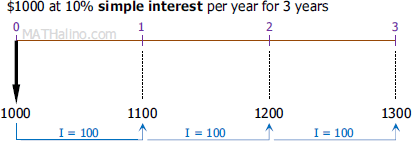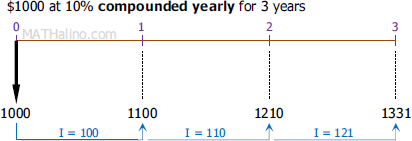Compound Interest
In compound interest, the interest earned by the principal at the end of each interest period (compounding period) is added to the principal. The sum (principal + interest) will earn another interest in the next compounding period.
Consider \$1000 invested in an account of 10% per year for 3 years. The figures below shows the contrast between simple interest and compound interest.
At 10% simple interest, the \$1000 investment amounted to \$1300 after 3 years. Only the principal earns interest which is \$100 per year.

At 10% compounded yearly, the \$1000 initial investment amounted to \$1331 after 3 years. The interest also earns an interest.

Elements of Compound Interest
$P$ = principal, present amount
$F$ = future amount, compound amount
$i$ = interest rate per compounding period
$r$ = nominal annual interest rate
$n$ = total number of compounding in t years
$t$ = number of years
$m$ = number of compounding per year
Future amount,
The factor $(1 + i)^n$ is called single-payment compound-amount factor and is denoted by $(F/P, \, i, \, n)$.
Present amount,
The factor $\dfrac{1}{(1 + i)^n}$ is called single-payment present-worth factor and is denoted by $(P/F, \, i, \, n)$.
Number of compounding periods,
Interest rate per compounding period,
Values of $i$ and $n$
In most problems, the number of years $t$ and the number of compounding periods per year $m$ are given. The example below shows the value of $i$ and $n$.
Example
Number of years, $t = 5 \text{ years}$
Nominal rate, $r = 18\%$
- Compounded annually ($m = 1$)
$n = 1(5) = 5$
$i = 0.18 / 1 = 0.18$
- Compounded semi-annually ($m = 2$)
$n = 2(5) = 10$
$i = 0.18 / 2 = 0.09$
- Compounded quarterly ($m = 4$)
$n = 4(5) = 20$
$i = 0.18 / 4 = 0.045$
- Compounded semi-quarterly ($m = 8$)
$n = 8(5) = 40$
$i = 0.18 / 4 = 0.0225$
- Compounded monthly ($m = 12$)
$n = 12(5) = 60$
$i = 0.18 / 12 = 0.015$
- Compounded bi-monthly ($m = 6$)
$n = 6(5) = 30$
$i = 0.18 / 6 = 0.03$
- Compounded daily ($m = 360$)
$n = 360(5) = 1800$
$i = 0.18 / 360 = 0.0005$
Continuous Compounding (m → ∞)
In continuous compounding, the number of interest periods per year approaches infinity. From the equation
$F = \left( 1 + \dfrac{r}{m} \right)^{mt}$
when $m \to \infty$, $mt = \infty$, and $\dfrac{r}{m} \to 0$. Hence,
$\displaystyle F = P \lim_{m \to \infty}\left( 1 + \dfrac{r}{m} \right)^{mt}$
Let $x = \dfrac{r}{m}$. When $m \to \infty$, $x \to 0$, and $m = \dfrac{r}{x}$.
$\displaystyle F = P \lim_{x \to 0}(1 + x)^{\frac{r}{x}t}$
$\displaystyle F = P \lim_{x \to 0}(1 + x)^{\frac{1}{x}rt}$
From Calculus, $\displaystyle \lim_{x \to \infty}(1 + x)^{1/x} = e$, thus,
- Add new comment
- 56136 reads
